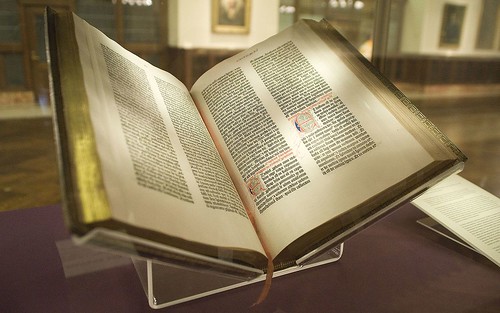
PREV ARTICLE
NEXT ARTICLE
FULL ISSUE
PREV FULL ISSUE
HAPPY ANNIVERSARY: GUTENBERG'S PRINTING PRESSBibliophiles celebrated an important anniversary
this week. Here's an excerpt from the September 30, 2016
edition of National Public Radio's Writer's Almanac
with Garrison Keillor -Editor
 On this day in 1452, the first section of the Gutenberg Bible was finished in Mainz, Germany, by the printer Johannes Gutenberg. Little is known of Gutenberg’s early history or his personal life except that he was born around the year 1400, the youngest son of a wealthy merchant. But from the time of the appearance of his beautiful Bibles, he has left an indelible mark on human culture. Ancient books had primarily been written on scrolls, though an innovation in the second century A.D. — that of the codex, a sheaf of pages bound at one edge — gave us the familiar book form we recognize today. Early codices were produced by hand by monks in scriptoriums, working with pen and ink, copying manuscripts one page at a time so that even a small book would take months to complete and a book the size of the Bible, rich with color and illuminations, would take years. Gutenberg’s genius was to separate each element of the beautiful, calligraphic blackletter script commonly used by the scribes into its most basic components — lowercase and capital letters, punctuation, and the connected ligatures that were standard in Medieval calligraphy — nearly 300 different shapes that were then each cast in quantity and assembled to form words, lines, and full pages of text. He also invented a printing press to use his type, researching and refining his equipment and processes over the course of several years. In 1440, Gutenberg wrote and printed copies of his own mysteriously titled book, Kunst und Aventur [Art and Enterprise], releasing his printing ideas to the public, and by 1450 his movable-type printing press was certainly in operation. Only four dozen Gutenberg Bibles remain, and of these only 21 are complete, but what Gutenberg created went far beyond the reach of those volumes. By beginning the European printing revolution, he forever changed how knowledge was spread, democratized learning, and allowed for thoughts and ideas to be widely disseminated throughout the known world. In his time, Gutenberg’s contemporaries called this “the art of multiplying books” and it was a major catalyst for the Renaissance, the Scientific Revolution, and even the Protestant Reformation. To read the complete article, see: Pictured is the New York Public Library's
Lenox copy of the Gutenberg bible (Wikipedia). -Editor
The Lenox copy, on paper, is the first Gutenberg Bible to come to the United States, in 1847. Its arrival is the stuff of romantic national folklore. James Lenox's European agent issued Instructions for New York that the officers at the Customs House were to remove their hats on seeing it: the privilege of viewing a Gutenberg Bible is vouchsafed to few. To read the complete Wikipedia entry, see: Printing press (https://en.wikipedia.org/wiki/Printing_press) THE BOOK BAZARREWayne Homren, Editor The Numismatic Bibliomania Society is a non-profit organization promoting numismatic literature. See our web site at coinbooks.org. To submit items for publication in The E-Sylum, write to the Editor at this address: whomren@gmail.com To subscribe go to: https://my.binhost.com/lists/listinfo/esylum All Rights Reserved. NBS Home Page Contact the NBS webmaster 
|